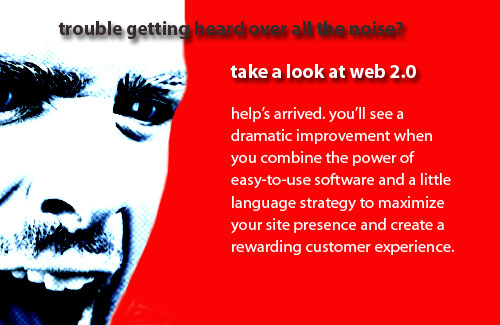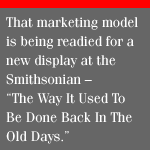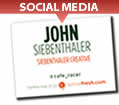
Web 2.0 – The Way It Will Be Done
March, 2006 | by John Siebenthaler

HOT SITE PICKS
del.icio.us
find it, store it, publish it
myspace
how gen-next connects: people, visual, audio
flickr
like to look at stuff? join the world for a view of anything and everything, tagged and indexed
technorati.com
the home of spin: if someone’s got an opinion, find it here
hyku.com
need help hooking up? josh hallet’s one of blogdom’s major stars — and knows all about the why and how
SOFTWARE TO GET STARTED
quick and easy software: 4 sites to get you started publishing right now
moveable type
typepad
blogger
wordpress
![]() KEYWORDS / TAGS
KEYWORDS / TAGS
take your time and use your head when setting up a keyword search engine strategy (we’re number one on ask.com)
(FORT WORTH, TX) As a manufacturer or retailer you’re used to communicating with your audience along traditional lines, mainly print mixed with a dab of web activism that revolves around back and forth (re: and fwd.) analog e-mailing. That marketing model is being readied for a new display at the Smithsonian – “The Way It Used To Be Done Back In The Old Days.” Don’t feel bad. You’re not the only one still using tin cans and a string.
This Spring I attended two events that were galaxies apart professionally but walked identical paths in terms of impact. At the heart of each was the concept of individualized communication.
A New Paradigm — Web Spending Passes Print At the same time, AdAge magazine reported last April that in 2006 digital media spending will for the first time surpass print. Say what? You mean those annoying little banner ads hyping 3% mortgages with no credit check are the road to the future? Yes, that and much more.
The implications are significant: more and more consumers are receiving – more and more selectively – the information they’ve decided they need from what is increasingly referred to as Web 2.0.
In Ft. Worth I sat in on two days worth of the Public Relations Society of America’s Southwest District Conference. Three weeks later I wandered miles of aisles in Orlando, dazed and bedazzled, at the GlobalShop “Build Your Brand” 2006 trade show, which is to an ad guy what whale blubber is to a bulemic Eskimo.
These events were bookends on a shelf I’ve labeled, “Survivor: Print Plus”. (Traditional media take note: high ground goes to the pubs who can successfully leverage digital into an integrated marketing plan, not fight it. Rolling Stone’s a great example.)
Lets start in Texas.
Long Tails, Garden Gnomes And Tagging The Public Relations Society of America is the largest professional association for pr practitioners in the world. Their members control or influence the majority of the commercial news you’re exposed to, and effectiveness and efficiency are crucial components of client service.
The “Life In The Fast Lane” keynote address featured the in-house (ouch!) campaign behind Travelocity’s precocious globe-trotting gnome. (Personally, I find garden gnomes as icons amusing only when they’re getting run over by a train, preferably while chained to their equally annoying metaphor, the mime and now the gecko. But that’s just me.)
The real revelation came in the form of several presentations that highlighted the transformation underway in how web communications are evolving into a global front porch environment.
The panel that drew the most interest was made up of three pr shops whose core practices center on creating web-based client value: Schipul – The Web Marketing Company, Houston; Idea Grove, Richardson; and Aristotle, in Little Rock. What they had to say was remarkable.
It’s referred to as “a long tail”, a somewhat controversial business model that simply means somewhere on the planet somebody’s interested in what you’ve got to say (blog) or sell (site). It’s a practice the corporate mindset is rapidly embracing and that’s at the very heart of viral marketing appeal, a strategy that does work effectively and is now being exploited by heavyweights like P&G.
The traditional view of internet marketing and communications is of a static web site — flash, almost always overdone, notwithstanding — some stale e-mail, and occasional hard copy info in the form of print ads or self-generated promo materials spackled over with an odd-lot collection of PDFs. In short, your message kind of lays around, hoping to be picked up and read.
The contemporary view is a different story and the fat lady on your watch is belting out tunes like an American Idol finalist. Big Business has suddenly latched on to what had been the domain of individuals with time to kill and a need to publish — blogs and the bloggers that inhabit them.
The Best Way To Maximize Site Presence My main interest is in the relatively narrow view of how best can manufacturers communicate with their market.
Returning calls or e-mails for info one at a time on the same topic, over and over, is a very poor allocation of resources.
Web pages have their drawbacks: expensive to maintain, relatively inflexible in terms of layout options and slow to update.
E-mail is to the web what a page is to a book. Great for discrete thoughts, either one to one or one to many, and for delivering some content, but not at all suitable for any two-way, ongoing dialogue.
Blogs are a direct, linear route for sharing selected client/customer interaction, the perfect solution to the ages-old problem of how best to deliver specific information in a timely manner at the lowest possible cost to communicate. A contraction of Web Log, this freshly minted noun/verb is part diary, part day journal, part email, part pen pal.
This isn’t a pitch for a typical star-crazed teenager’s personal homage to the latest pop culture icon. It is a recognition of the utility, ease-of-use and outright practicality that even the most basic blog emobodies. More than that, it’s about the brilliance of allowing your market to define your goods and services through tagging in a way that’s much more conducive to acceptance and understanding by your audience.
For the first time, content-regulated multi-user communications can be posted for public response and reaction in an easily controlled (and surprisingly low cost) dialogue form. That’s remarkable in itself, but the real value is in the way content can be identified and rated based on what the audience thinks is relevant.
Blogs Offer Features Web Pages Can’t Match A blogger posts comments and subscribers interact directly to form a linear dialogue that’s controllable, measurable and – here’s the deal closer — searchable. How? Keywords and tags. An added bonus is that the format is much, much easier to manage than updating or creating web pages.
If in the past you’ve depended on site FAQs (Frequently Asked Questions) to answer the same questions over and over, the view has changed. Those same questions can now be tagged, enhanced, and expanded to encompass new information in a real-time interactive setting.
It means consumers get an opportunity to talk back, a potentially lucrative source of data. Any viewer can read, registered readers can participate and misbehavers can be locked out.
The companies that fail to grasp the monster value of this paradigm to a gadgets and gears oriented marketplace that eats techno for breakfast should be slated for extinction. And probably will be.
What’s It Like To Live In Web 2.0? Ever heard of myspace? Or flickr? Myspace.com is currently the best known example of an amazing hybrid — an online social network. I mention it not because I’m a big fan, but simply because myspace represents the way our lifestyles have been altered, whether we like it or not.
Web 2.0 is nothing more than an umbrella phrase that encompasses various aspects of evolving technology and the way it interacts with society; SVG, podcasts, vblogs, blogs, tagging and RSS (Really Simple Syndication, the technique that delivers selected headlines directly to your browser or Blackberry).
In practical terms this means the number of communication pathways available for distributing your message is way beyond traditional ink and paper. The message can be instantaneous and global, while content and delivery are customizable based on individual preferences and devices.
Those devices range from desktop pcs to RAZR cellphones, all capable of displaying essentially the same text, audio or visual content. (How is your content structured? Widest possible audience, or vertically stacked in a tightly bound corporate column?)
To get a better insight into harnessing that power for your own marketing purposes, visit del.icio.us and search for, say, “motorcycle helmet”. Then skip over to technorati.com and do the same.
And now the “but”. The glue that holds all the bells and whistles together is content. Content equals talent and diligence regularly applied. Without it blogging and casting are nothing more than thoughts out loud that nobody cares about.
Print won’t go away — keeping in mind that just a few years ago I was rock solid in my view that film would never succomb to digital — but it won’t prosper if it doesn’t figure out how to integrate the new reality of Web 2.0.
Next: GlobalShop – Where What You Buy Is Already Decided




